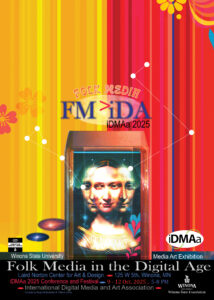Art exhibition of the iDMAa Festival and Conference 2025 : “Folk Media”
International Digital Media and Art Association Conference 2025
Exhibiting art of internationally known artists that challenge folk and traditional narratives through digital contexts.
9-12 October 2025
Opening hours: 5-8 PM
Laird Norton Center for Art & Design
Winona State University, Winona, MN, USA
Sponsored by WSU Foundation.
Curated by Negin Ehtesabian & Patrick Lichty
With thanks to the Winona State Foundation, the Creative Digital Media program, the Communication & Media Department, the Department of Art & Design, Dr. Talan Memmott, Dr. Davin Heckman, & Winona State University.
Featured Artists: (Alphabetical Order)
Afra Al Dhaheri (UAE) @afra_aldhaheri
Almagul Menlibayeva (Germany/ Kazakhstan) @almagul.menlibayeva
Bibbe Hansen (USA) @bibbe.hansen
Claudia Hart (USA) @claudhart
FUBAR/Dina & Vedran Gligo (Croatia) @fubar_expo
Genco Gulan (Turkey) @gencogulan
Judith Carlin (USA) @judith_carlin
Lee Wells (Greece/USA) @lee_wells_art
Michael Ang (Canada/ UAE) @mangtronix
Mina Cheon (USA/South Korea) @minacheonstudio
Mindaugas Gapsevicius- Miga (Germany/Lithuania) @gapsevicious
Nathan Shafer (USA- Alaska) @nathan_shaferak
Nina Sumarac (Cyprus/ Serbia) @ninaschumaratz
Sara Niroobakhsh (Canada/ UAE/ Iran) @saraniroobakhsh
Talan Memmott (USA) @talmott
Walter Willems (Netherland/UAE) @walterwillems
>>>
FM>iDA invites audiences to explore how traditional folk narratives resonate with contemporary artists in the digital age. Each piece challenges conventions while offering fresh perspectives on identity, community, and culture. This showcase underscores iDMAa’s commitment to pioneering cross-cultural dialogue in a rapidly evolving media landscape.
In this exhibition, we claim that folk media, the oral tales, the hand-made image, the communal song, ritual object, have not vanished in the age of digital spectacle. Instead, it transforms, disperses, and multiplies within digital networks. If folk media once traveled by footpaths and village squares, today it travels by internet and screens, but its core impulse remains: to tell, to bind, to remember, and to provoke.
Folk media survives because it answers timeless human needs—sharing wisdom, hope, pain, fear, unity, worshipping or celebrating, sharing rituals, defining priorities of the time, and codifying collective memory.
The digital era amplifies these needs. Stories become shareable units, rituals migrate to online platforms, and communities flourish around micro-narratives, memes, and participatory media.
Let’s call it Transformation, Not Substitution. The tool shifts; from voice and gesture to code, algorithm, and interface.
Folk Media as Digital-Matter:
Digital tools democratize authorship; a grandmother’s tale can become a generative prompt, a grandmother’s embroidered motif becomes a pixelated motif, a local tune becomes a looping sample. The archive expands from physical to virtual; Memory is no longer contained by borders; it circulates, mutates, and accumulates across communities and platforms throughout the entire world; leading to more similar online collective memories, and re-narrates every culture/language, like old folkloric stories and songs. But this time, the access and borders of influence is unlimited by geography.
In this vast inclusive meaning, political art, disability art and digital storytelling are included.
If folk media once traveled by foot and memory, it now travels by code and cloud, and asks enduring questions: What do we remember together? Who gets to tell the story? How do we preserve authenticity while embracing transformation?
More about iDMAa: https://idmaa.org/
Contact: pa************@****na.edu
